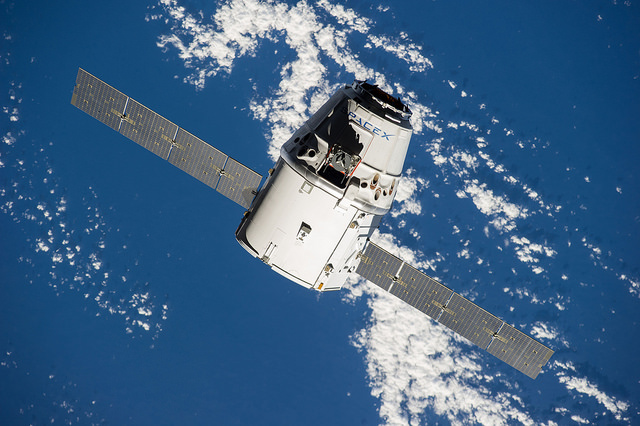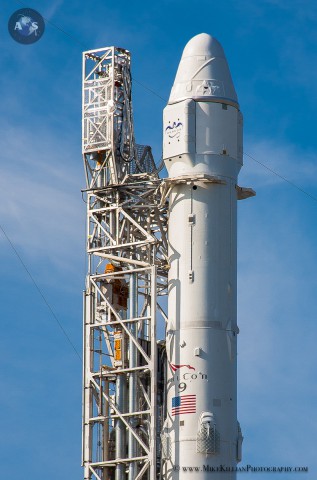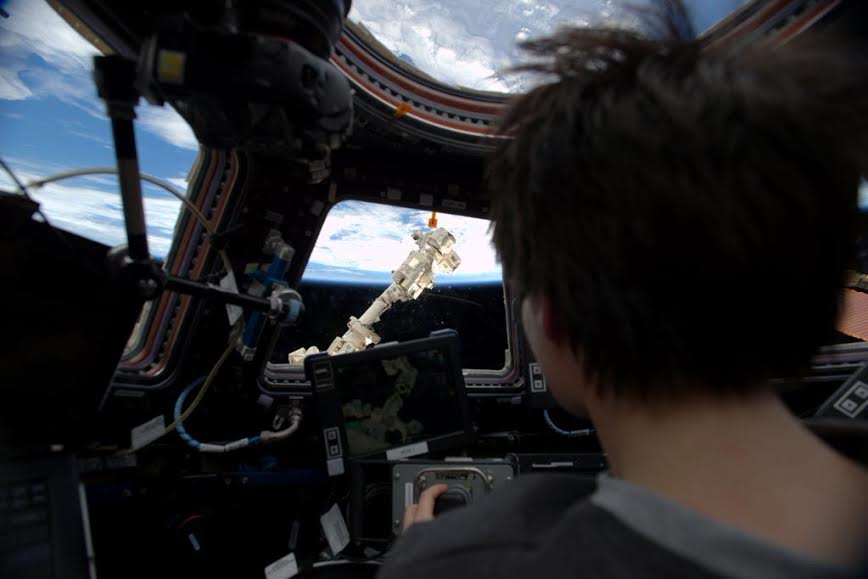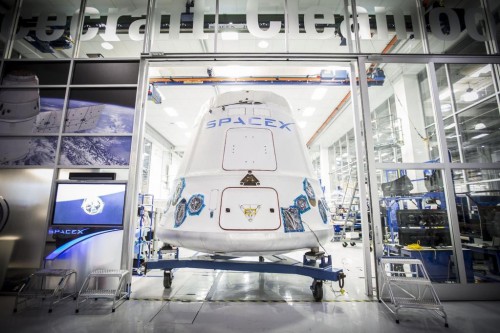
SpaceX is gearing up for the next round of its most ambitious year of launches and tests to date, with next week’s scheduled flight of the sixth dedicated Dragon cargo mission (CRS-6) toward the International Space Station (ISS). Liftoff of the unpiloted cargo craft—which is being flown under the language of the $1.6 billion Commercial Resupply Services contract, signed between NASA and SpaceX back in December 2008—is presently targeted to occur during an “instantaneous” window at 4:33 p.m. EDT Monday, 13 April. Like each of its predecessors, this mission will fly from the storied Space Launch Complex (SLC)-40 at Cape Canaveral Air Force Station, Fla., atop the Falcon 9 v1.1 booster. If SpaceX is unable to meet this window, it has Eastern Range clearance to recycle 24 hours for a backup attempt at 4:10 p.m. EDT Tuesday, 14 April. According to NASA, the CRS-6 mission will transport about 4,390 pounds (1,990 kg) of provisions, payloads, tools, and scientific experiments to the space station’s incumbent Expedition 43 crew.
This will be SpaceX’s fourth launch in as many months, following hard on the heels of the CRS-5 Dragon to low-Earth orbit, bound for the ISS, on 10 January, NASA’s Deep Space Climate Observatory (DSCOVR) toward the L2 Lagrange Point—which marked the Hawthorne, Calif.-based company’s first foray beyond Earth orbit—on 11 February, and, most recently, the Eutelsat 115 West B and ABS-3A communications satellites to Geostationary Transfer Orbit (GTO) on 1 March. SpaceX’s original manifest then called for the launch of Turkmenistan’s first national satellite, TurkmenAlem52E/MonacoSat—also internally known as “Thales,” in honor of its manufacturer, the Paris, France-headquartered Thales Group—on 21 March, followed by the long-awaited Pad Abort Test (PAT) of a modified Dragon vehicle from SLC-40 in early April, as part of the pathway toward Commercial Crew operations, and finally CRS-6 on 10 April.
This schedule was cast into disarray in mid-March, however, when an issue was detected with a batch of Falcon 9 v1.1 helium pressurization bottles during tests at SpaceX’s manufacturing facility. “During stress-testing helium bottles of a similar lot, we identified a potential condition that could be shared with those on-board the Thales vehicle,” SpaceX told AmericaSpace on 19 March. “While it’s unlikely that the flight helium bottles would have encountered an issue during the mission, out of an abundance of caution, we have opted to replace a few of the flight bottles.” Speaking last month to Aviation Week, SpaceX President and CEO Gwynne Shotwell pointed out that the bottles “passed inspection,” but added that “now is not the time to have an issue in-flight.” In the immediate aftermath of the delay, SpaceX submitted a new date to the Eastern Range for the TurkmenAlem52E/MonacoSat flight. “With the time required to make the change, along with Range availability,” SpaceX told AmericaSpace, “our target date for the mission is now 24 April.” By the beginning of April, it was added that “Replacement of the helium bottles is nearing completion.”

In the meantime, it was understood that the PAT would be moved from its original position in early April to the beginning of May. “We have more flexibility with the Pad Abort schedule,” SpaceX explained, “so we’re evaluating the best dates in light of the two missions we have coming in April.” The Dragon vehicle assigned to the PAT, meanwhile, was delivered to Cape Canaveral Air Force Station in February 2015 for final processing operations. It will be mounted onto a support structure at SLC-40, and the test will be subject to an in-depth AmericaSpace preview article, closer to the time. “The whole test is less than two minutes from pad to splashdown,” SpaceX told us, “and most of that distance is covered in the first 25-30 seconds of the test.” Since it is a test, the company does not intend to webcast the PAT.
With CRS-6 expected to launch next week, this makes 2015 the first year in SpaceX’s history that it has delivered missions aloft in as many as four consecutive months. It will be the second ISS-bound Dragon, following January’s CRS-5, and with three more scheduled to fly, this will also make 2015 a banner year, with five flights. If these are executed according to the manifest, CRS-6 will be followed by CRS-7 in June and CRS-9 in December, each of which will carry an International Docking Adapter (IDA) to support NASA’s Commercial Crew needs, whilst CRS-8 in September will deliver the Bigelow Expandable Activity Module (BEAM) to the space station. To date, SpaceX has launched no more than two Dragons per year since its inaugural Commercial Orbital Transportation Services (COTS) test flight, back in May 2012, and if all goes well the company will have completed 75 percent of its 12-flight CRS commitment to NASA by year’s end, with the remainder expected to be conducted in 2016.
Unlike this year’s other Dragons, CRS-6 will carry no major payload in its unpressurized “Trunk” Section. CRS-5 in January carried the Cloud Aerosol Transport System (CATS), and the remaining flights will carry the IDAs and BEAM, all intended for robotic removal from their trunks—by means of the 57.7-foot-long (17.6-meter) Canadarm2—and attachment to the space station. The CRS-6 trunk will be empty, although the pressurized segment of the spacecraft will be loaded with about 4,390 pounds (1,990 kg) of provisions, payloads, tools, and scientific experiments for the incumbent Expedition 43 crew, which consists of Commander Terry Virts of NASA, Russian cosmonauts Anton Shkaplerov, Gennadi Padalka, and Mikhail Kornienko, U.S. astronaut Scott Kelly, and Italy’s first woman in space, Samantha Cristoforetti. As of today (Tuesday), Virts, Shkaplerov, and Cristoforetti are entering their 135th day in orbit, whilst Padalka, Kornienko, and Kelly have been in space for a little less than two weeks.
Like CRS-5, whose thunderous January ascent was captured by AmericaSpace’s photography team in a spectacular folio of launch imagery, the CRS-6 mission is expected to follow a two-day rendezvous protocol, ahead of being captured and berthed by Canadarm2 at the Earth-facing (or “nadir”) port of the station’s Harmony node on Wednesday, 15 April. At the controls of the Canadian-built mechanical arm, and based inside the multi-windowed cupola, will be Cristoforetti, backed up by Virts and supported by newly-arrived One-Year crew member Kelly. After capturing Dragon at about 7:14 a.m. EDT, it should be berthed at Harmony nadir about two hours later, after which the crew will ingress the cargo ship and begin the process of unloading one of the largest loads of equipment and supplies ever delivered to the ISS by SpaceX.

That cargo consists of 1,100 pounds (500 kg) of crew supplies, including care packages from home, food and provisions, 1,140 pounds (518 kg) of miscellaneous items for the station’s Environmental Control and Life Support System (ECLSS) and Electrical Power System (EPS), 1,860 pounds (844 kg) of “Utilization” hardware—including U.S.-sponsored experiments and research payloads from the Canadian Space Agency (CSA), the Japan Aerospace Exploration Agency (JAXA), and the European Space Agency (ESA)—and about 79 pounds (36 kg) of command and data-handling equipment, TV and photographic gear, and EVA tools.
Although it was stressed to AmericaSpace by NASA’s Dan Huot that final payload determinations would be made before the end of the week, what is readily apparent is that CRS-6 will be one of the most science-heavy Dragon flights to date. Canada will provide hardware for its ongoing “Tomatosphere” experiment, which seeks to increase the interest of students in the space sciences and horticulture technology, as well as enhancing familiarity and experience with research methodologies. Since its creation in 2001, Tomatosphere has delivered approximately 600,000 tomato seeds to the ISS, as part of an ongoing experiment which has allowed two million students from over 13,000 Canadian schools to measure germination rates, growth patterns, and vigor. Provided by U.S. and Canadian companies, the seeds will begin to address questions of how to supply long-duration exploration missions beyond low-Earth orbit, with the life-support requirements of food, water, oxygen, and the need to consume carbon dioxide exhaled by crew members. Two years ago, Tomatosphere won the Natural Sciences and Engineering Research Council of Canada (NSERC) Award for Science Promotion. The project has led to a number of educational units, aimed at Grades 3-10, focusing on astronaut nutrition, the recycling of breathable air, and how to someday survive in the hostile environment of Mars.

Meanwhile, ESA has provided three payloads for delivery to the ISS aboard CRS-6. These include the latest batch of biological cell samples (Kubik-5) for the Kubik incubator/cooler, which is situated aboard Europe’s Columbus laboratory module. This controlled-temperature device operates between 6-38 degrees Celsius (42.8-100.4 degrees Fahrenheit) and carries removable inserts—including a centrifuge insert for simultaneous 1G “control” samples to run alongside microgravity samples—for self-contained, automatic experiments involving seeds, immune cells, or small animals. It has supported numerous investigations, spanning ISS Expeditions 17-26 between April 2008 and March 2011, Expeditions 29-30 from September 2011 through April 2012, and currently Expeditions 43-44 through September 2015. Other ESA payloads include samples for TripleLux-A, which will be housed inside the Biolab facility aboard Columbus and which seeks to understand the negative mechanisms of microgravity, including the effects of radiation, upon cells from rats, mussels, and bacteria. It is hoped that this research may safeguard the health of future astronauts, as well as sufferers of weakened immune systems on Earth. Lastly, CRS-6 will carry hardware for the Cardiolab Holter Arterial Blood Pressure (CDL HLTA) instrument, which examines the relationship between salt intake the cardiovascular system in microgravity conditions.
In addition to the Canadian and European payloads, a wide range of other experiments and equipment from Japan and the United States will also ride uphill aboard Dragon. JAXA investigations are centered upon the process of aging in microgravity, observations of the gravity-sensing organs of plants, microbial analysis, and the Tanpopo astrobiology study. Meanwhile, U.S. experiments will focus on the ongoing “Twins Study”—which involves One-Year Crewman Scott Kelly and his Earth-bound identical twin brother, former astronaut Mark Kelly—and a variety of other research goals, including bone and muscle degradation, nanoparticles and osteoporosis, blood sampling, microbial analysis, fluid shifting, protein crystal growth, biological investigations, sleep studies, and plant growth. The U.S. load will also include power and data cables for the Expedite the PRocessing of Experiments for Space Station (ExPRESS) multi-purpose research racks, IMAX photographic hardware, supplies for the ISSPresso on-board coffee machine, and a Microgravity Experiment Research Locker Incubator (MERLIN).
Also aboard CRS-6 is the Rodent Research-2 investigation, which consists of a group of mice, being flown as part of an ongoing study of mammalian physiology in the microgravity environment. In September 2014, the Rodent Research-1 payload was launched to the ISS aboard SpaceX’s CRS-4 Dragon, marking the first occasion that rodents had ever been delivered to the station aboard an unpiloted commercial cargo ship. Lasting 37 days, it was the longest rodent study ever conducted aboard a NASA facility in the weightlessness of space, and was returned to Earth in late October aboard Dragon. They were accommodated in the Rodent Research Hardware System, which comprised three units: a transporter module, which they occupied during launch and the journey to the ISS, and an access module, which the station crew used to transfer them into a habitat module for the duration of their stay in orbit. Sponsored by the Center for the Advancement of Science in Space (CASIS), the Rodent Research-2 experiment seeks to study the rodents’ immune response to an injected vaccine, which will activate the immune system in a manner not dissimilar to a virus.
After the mice have been exposed to the microgravity environment for about two weeks, they will be inoculated with a TT vaccine. A subset of these mice will also receive the CpG adjuvant at the time of inoculation. Two weeks later, during the peak of the primary response, the mice will be euthanized in the Materials Science Glovebox (MSG). According to NASA, euthanasia is achieved via an intraperitoneal injection of ketamine/xylazine anesthesia, followed by exsanguination by cardiac puncture. Spleens are dissected from the mice, sectioned, and frozen at -80 degrees Celsius (-112 degrees Fahrenheit) in a cold block within a Mini Cold Bag (MCB). Bloods will be separated by centrifugation and serum will be frozen. Frozen spleen and serum samples will then be stored in a Minus Eighty Laboratory Freezer (MELFI) until they can be returned to Earth for analysis.
Assuming an on-time launch on Monday, 13 April, and satisfactory berthing on Wednesday, 15 April, it is anticipated that CRS-6 will remain in residence at the ISS for about five weeks, before returning to a parachute-assisted splashdown in the Pacific Ocean, off the California coast.
Want to keep up-to-date with all things space? Be sure to “Like” AmericaSpace on Facebook and follow us on Twitter: @AmericaSpace
Missions » ISS » COTS » CRS-6 » Missions » ISS »




Goooooo SpaceX……..
Land on the Barge!!! Watch Lockheed Martin announce the renewed testing of the X-33 SSTO concept craft.
I wonder if SpaceX could put a disposable pressurized cargo module in the extended version of the Dragon’s trunk. It would increase the amount of pressurized cargo that could be carried. At the end of mission, it could be used to dump the ISS’s garbage.
Nicely done Ben! You must have contacts in high places 😉
Why are they doing another instantaneous window?!? Given that rockets of all kinds are prone to problems and delays, having an instantaneous window basically all but guarantees delays. Might as well stop calling them windows and start calling them pinholes instead
ISS is a moving target in a high inclination orbit. ‘Instantaneous’ launch windows may actually be a few minutes, but for the most part any window under 10 minutes may as well be considered instantaneous. If you have to call a hold at the 5 minute mark, it’s unlikely you’ll have it resolved inside the window, after all. This is fairly routine for cargo runs; ESA and Orbital do/did it the same way.
Also, while they could just try again 90 minutes later on the next orbit, the station crew that handle berthing the spacecraft have busy schedules. So they’d probably prefer not having to block out multiple periods of time in the same day where they might be needed.
Those same constraints would be on any other launch from the Cape Canaveral Air Force Station to the ISS.
Shuttle made such flights for quite a while, but I never heard the “instantaneous” descriptor used before.
Did I just miss it or is this a recent addition to the lexicon?
A recent SpaceX launch to one of the Lagrangian points was termed “instantaneous” and that one did indeed have to be launched on-the-dot, with no window to speak of.
Never in the history of ISS or Mir rendezvous launches from Florida (51.6 degree inclination) has there been the need for that kind of launch, so I’m wondering if that term “instantaneous” is used mistakenly here.
Thanks.
Did a search on “instantaneous launch” and got over 61,000 results.
Obviously could not check them all, but the ones checked all seemed to deal with missions aimed at Beyond LEO and using direct insertion into the transfer trajectory.
So you are probably correct.
FWIW,
http://spaceflightnow.com/ariane/va219/140729preview/
http://www.universetoday.com/101449/how-to-spot-the-antares-launch-from-nasa-wallops-on-wednesday/
http://www.spaceflight101.com/atv-4-mission-updates.html
So whether or not it’s accurate to use the term, it certainly has been being used for LEO missions for a few years now.